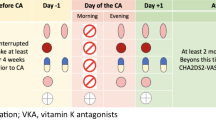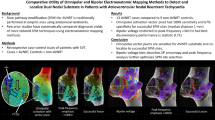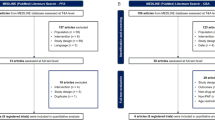Abstract
Background
The significance of atrial fibrillation (AF) recurrences during the 90-day blanking period following catheter ablation is controversial. Studies to date examining the impact of AF recurrences during the blanking period have been limited by intermittent monitoring. We sought to test whether AF recurrences during the blanking period are associated with long-term recurrences using continuous monitoring.
Methods
Patients undergoing AF ablation by a single operator at an academic medical center between 2015 and 2019, who either already had a cardiac implantable electronic device (CIED) with an atrial lead or received an insertable cardiac monitor (ICM), were followed for long-term AF recurrence. Recurrence was defined as > 30 s by CIED and > 2 min by ICM. All device-reported AF episodes were adjudicated by a physician.
Results
Of 196 consecutive patients, 51 (26%) had AF recurrence in the blanking period and 145 (74%) did not. Over the year following ablation, those who had an AF recurrence in the blanking period were significantly more likely to have long-term AF recurrences than those without AF in the blanking period (log rank p < 0.001). The higher the burden of AF recurrences during the blanking period, the more likely AF was to recur long-term (hazard ratio 1.04 [CI 1.01–1.06] per 1% increase in burden, p = 0.002).
Conclusion
Using continuous monitoring of a sizable population, we confirmed that AF recurrences in the blanking period following ablation are in fact associated with long-term AF recurrences. The higher the burden of recurrence, the more likely AF is to recur long-term.

Similar content being viewed by others
Abbreviations
- AF:
-
Atrial fibrillation
- CIED:
-
Cardiac implantable electronic devices
- LTR:
-
Long-term recurrence
- ICM:
-
Insertable cardiac monitor
References
Calkins H, Hindricks G, Cappato R, et al. 2017 HRS/EHRA/ECAS/APHRS/SOLAECE expert consensus statement on catheter and surgical ablation of atrial fibrillation. Heart Rhythm. 2017;14(10):e275–444.
Liang JJ, Elafros MA, Chik WW, et al. Early recurrence of atrial arrhythmias following pulmonary vein antral isolation: timing and frequency of early recurrences predicts long-term ablation success. Heart Rhythm. 2015;12(12):2461–8.
Richter B, Gwechenberger M, Socas A, Marx M, Gossinger HD. Frequency of recurrence of atrial fibrillation within 48 hours after ablation and its impact on long-term outcome. Am J Cardiol. 2008;101(6):843–7.
Oral H, Knight BP, Ozaydin M, et al. Clinical significance of early recurrences of atrial fibrillation after pulmonary vein isolation. J Am Coll Cardiol. 2002;40(1):100–4.
Lee SH, Tai CT, Hsieh MH, et al. Predictors of early and late recurrence of atrial fibrillation after catheter ablation of paroxysmal atrial fibrillation. J Interv Card Electrophysiol. 2004;10(3):221–6.
Joshi S, Choi AD, Kamath GS, et al. Prevalence, predictors, and prognosis of atrial fibrillation early after pulmonary vein isolation: findings from 3 months of continuous automatic ECG loop recordings. J Cardiovasc Electrophysiol. 2009;20(10):1089–94.
Themistoclakis S, Schweikert RA, Saliba WI, et al. Clinical predictors and relationship between early and late atrial tachyarrhythmias after pulmonary vein antrum isolation. Heart Rhythm. 2008;5(5):679–85.
Liang JJ, Elafros MA, Muser D, et al. Pulmonary vein antral isolation and nonpulmonary vein trigger ablation are sufficient to achieve favorable long-term outcomes including transformation to paroxysmal arrhythmias in patients with persistent and long-standing persistent atrial fibrillation. Circ Arrhythm Electrophysiol. 2016;9(11).
Santangeli P, Marchlinski FE. Techniques for the provocation, localization, and ablation of non-pulmonary vein triggers for atrial fibrillation. Heart Rhythm. 2017;14(7):1087–96.
Calkins H, Gache L, Frame D, et al. Predictive value of atrial fibrillation during the postradiofrequency ablation blanking period. Heart Rhythm. 2021;18(3):366–73.
Diederichsen SZ, Haugan KJ, Kronborg C, et al. Comprehensive evaluation of rhythm monitoring strategies in screening for atrial fibrillation: insights from patients at risk monitored long term with an implantable loop recorder. Circulation. 2020;141(19):1510–22.
Lellouche N, Jais P, Nault I, et al. Early recurrences after atrial fibrillation ablation: prognostic value and effect of early reablation. J Cardiovasc Electrophysiol. 2008;19(6):599–605.
Yanagisawa S, Inden Y, Kato H, et al. Effect and significance of early reablation for the treatment of early recurrence of atrial fibrillation after catheter ablation. Am J Cardiol. 2016;118(6):833–41.
Funding
This work was supported by the Mark Marchlinski EP Research & Education Fund.
Author information
Authors and Affiliations
Contributions
Drs. Amankwah, Pothineni, and Frankel made substantial contributions to the conception and design of the work, as well as acquisition, analysis, and interpretation of the data. All other authors critically revised the manuscript for important intellectual content and approved the submitted version. The authors read and approved the final manuscript.
Corresponding author
Ethics declarations
There are no potential conflicts of interest to disclose. All patients provided written informed consent and the study was approved by the Institutional Review Board.
Competing interests
The authors declare that they have no competing interests.
Additional information
Publisher's note
Springer Nature remains neutral with regard to jurisdictional claims in published maps and institutional affiliations.
Rights and permissions
About this article
Cite this article
Amankwah, N.A., Pothineni, N.V.K., Guandalini, G. et al. Impact of atrial fibrillation recurrences during the blanking period following catheter ablation on long-term arrhythmia-free survival: a prospective study with continuous monitoring. J Interv Card Electrophysiol 65, 519–525 (2022). https://doi.org/10.1007/s10840-022-01291-0
Received:
Accepted:
Published:
Issue Date:
DOI: https://doi.org/10.1007/s10840-022-01291-0




